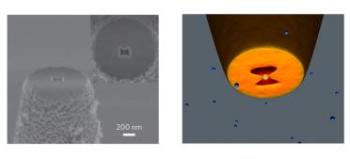Mar 3 2014
As science and technology go nano, scientists search for new tools to manipulate, observe and modify the "building blocks" of matter at the nanometer scale. With this in mind, the recent publication in Nature Nanotechnology in which ICFO researchers demonstrate for the first time the ability to use near-field optical tweezers to trap a nano-size object and manipulate it in the 3 dimensions of space, is an exciting achievement.
Romain Quidant, ICREA Professor and leader at ICFO of the Plasmon Nano-Optics research group comments that "this technique could revolutionize the field of nanoscience since, for the first time, we have shown that it is possible to trap, 3D manipulate and release a single nano-object without exerting any mechanical contact or other invasive action".
 The image on the left is an electron beam microscopy image of the extremity of the plasmon nano-tweezers. The image on the right is a sketch illustrating the trapping of a nanoparticle in the bowtie aperture. Credit: Institute of Photonic Sciences
The image on the left is an electron beam microscopy image of the extremity of the plasmon nano-tweezers. The image on the right is a sketch illustrating the trapping of a nanoparticle in the bowtie aperture. Credit: Institute of Photonic Sciences
Imagine an elephant trying to grab an object the size of a needle with its gigantic hoof? Clearly this would be a tremendous if not impossible challenge because of the elephant's enormous size in comparison to that of the needle. Now imagine that our needle is a single molecule or tiny object about the size of a few nanometers and we, with our conventional tools, need to trap it and manipulate it in in order to, for example, understand its implication in the development of a disease. We have the same problem, first because a conventional optical microscope is not capable of visualizing a single molecule and second, because the physical limitations of our conventional tweezers are simply not capable of grasping or manipulating such small objects.
Invented in Bell Labs in the 80's, the original optical trapping demonstrated great capability to trap and manipulate small objects of micrometer size dimensions using laser light. By shining a laser light through a lens, it is possible to focus light in a tiny spot, creating an attractive force due to the gradient of the light intensity of the laser and thus attracting an object/specimen and maintaining it in the spot/focus.
While Optical tweezers have changed forever the fields of both biology and quantum optics, the technique has considerable limitations, one of which being its inability to directly trap objects smaller than a few hundreds of nanometers. This drawback prompted the pursuit of new approaches of nano-tweezers based on plasmonics, capable of trapping nano-scale objects such as proteins or nanoparticles without overheating and damaging the specimen. A few years ago, ICFO researchers demonstrated that, by focusing light on a very small gold nano-structure lying on a glass surface which acts as a nano-lens, one can trap a specimen at the vicinity of the metal where the light is concentrated. This proof of concept was limited to demonstrate the mechanism but did not enable any 3D manipulation needed for practical applications.
Now researchers at ICFO have taken this a crucial step further by implementing the concept of plasmonic nano-tweezers at the extremity of a mobile optical fiber, nano-engineered with a bowtie-like gold aperture. Using this approach, they have demonstrated trapping and 3D displacement of specimens as small as a few tens of nanometers using an extremely small, non-invasive laser intensity. Central to the great potential of this technique is that both trapping and monitoring of the trapped specimen can be done through the optical fiber, performing the manipulation of nano-objects in a simple and manageable way outside of the physics research lab.
This technique opens a plethora of new research directions requiring non-invasive manipulation of objects at the single molecule/virus level. It is potentially attractive in the field of medicine as a tool to further understand the biological mechanisms behind the development of diseases. Likewise, it holds promise in the context of nanotechnologies to assemble future miniature devices, among other exciting potential applications.